Why yes, I was out early this morning in pursuit of astronomical shenanigans, to see if our impish little moon was playing hide-and-seek. Well, there was no uncertainty about that, since we’ve possessed the knowledge of orbital mechanics since before we called a hashtag a pound sign – it was definitely going to happen. But there remained the question of whether I would be able to see it. Though let’s not get ahead of ourselves.
[Isn’t the suspense fabulous?]
I took an establishing photo about 20 minutes before the moon was to enter the penumbra of the Earth’s shadow, for comparison’s sake.
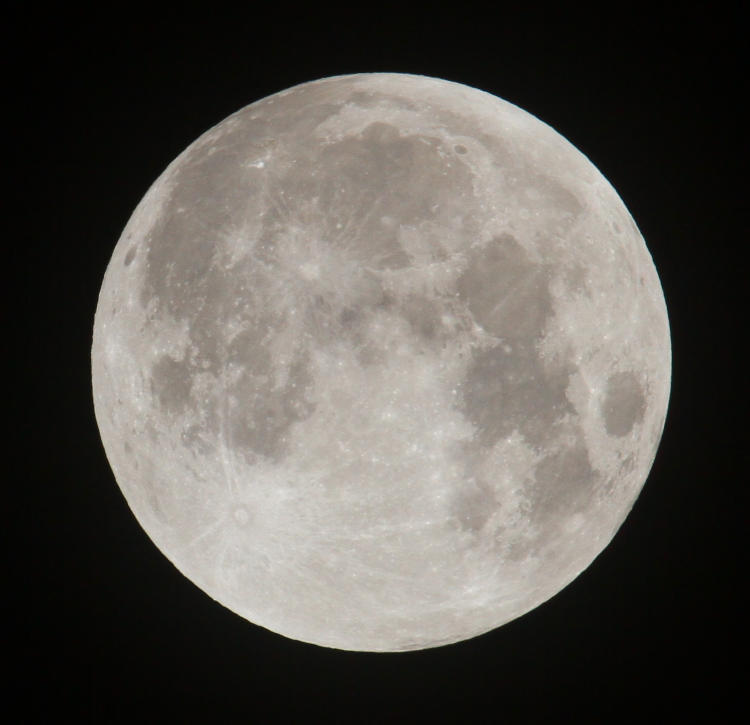
For lunar eclipses, there are two aspects of the shadow that’s thrown. The penumbra is the indistinct outer shadow where light is reduced but no real shape is discernible, and for the most part, you really can’t tell. Astronomers make a big deal of noting this, but your eye will compensate readily, and the reduction of light is considerably less than, say, a thin layer of haze, so big deal. I knew things were going to take a long time and the night was fairly chilly, not to mention my viewing location would be on the side of a lake where the temperature and the wind would make things less comfortable, so I wasn’t in a hurry to begin the sequence, and I aimed to be down there shortly before the umbral eclipse started. The umbra is the distinct shadow that actually has an edge to it, even when it’s not ‘sharp.’
Shortly before the umbral phase began, things looked notably different:
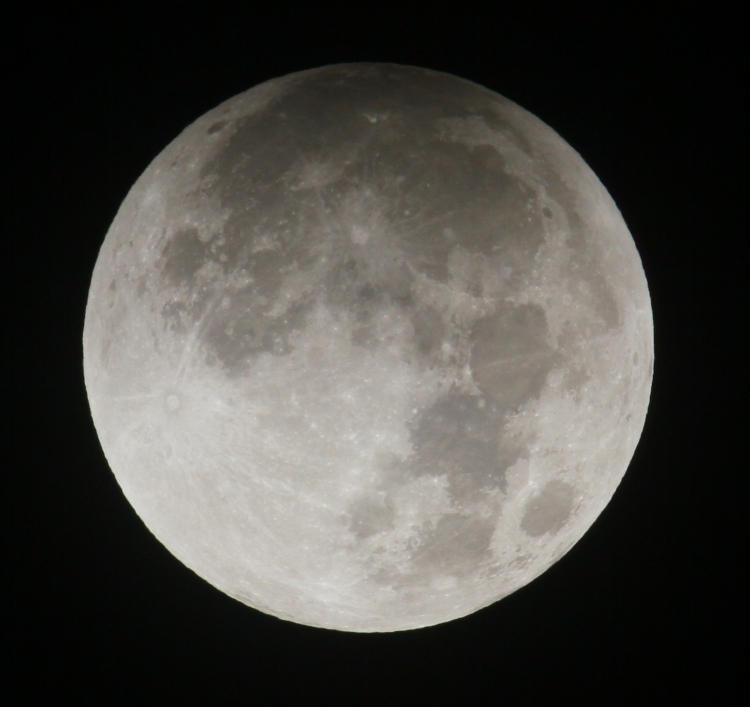
We’re into technicalities now, because the moon hadn’t started entering the umbra yet, but you could easily make out a dark shadow at the top by naked eye. The haze and clouds seen during my earlier check (previous post) and even for the top image had blown away by this point, so there were scattered patches in the sky but none near the moon – the ‘seeing’ was pretty good, at least in that direction. Okay then.
A bit of meaningless trivia: While I could easily see the darkened section by eye, and even in the LCD preview after snapping the image, in the viewfinder it was difficult to tell an eclipse was going on at this point – curious.
You might also have noticed, by looking at Tycho’s splash for example, that the moon seems to oriented differently, and it is, because it arcs across the sky. Consider the moon’s south pole to be anchored to our own southern horizon – close enough for our purposes, because it’s not (almost not) the moon’s movement, but the Earth’s, that makes it track across the sky. Meanwhile, we on the Earth’s surface orient ourselves while pointing towards the center of gravity rather than with the axis, so the moon will appear to rotate clockwise over the course of the night.
I made it a point to maintain the exact same exposure setting for a sequence of shots, for comparison, even though I varied things in between. Such as, while the moon was just showing a little chunk out of the top, I did a couple of long exposures by its light, which remained very bright and distinct.
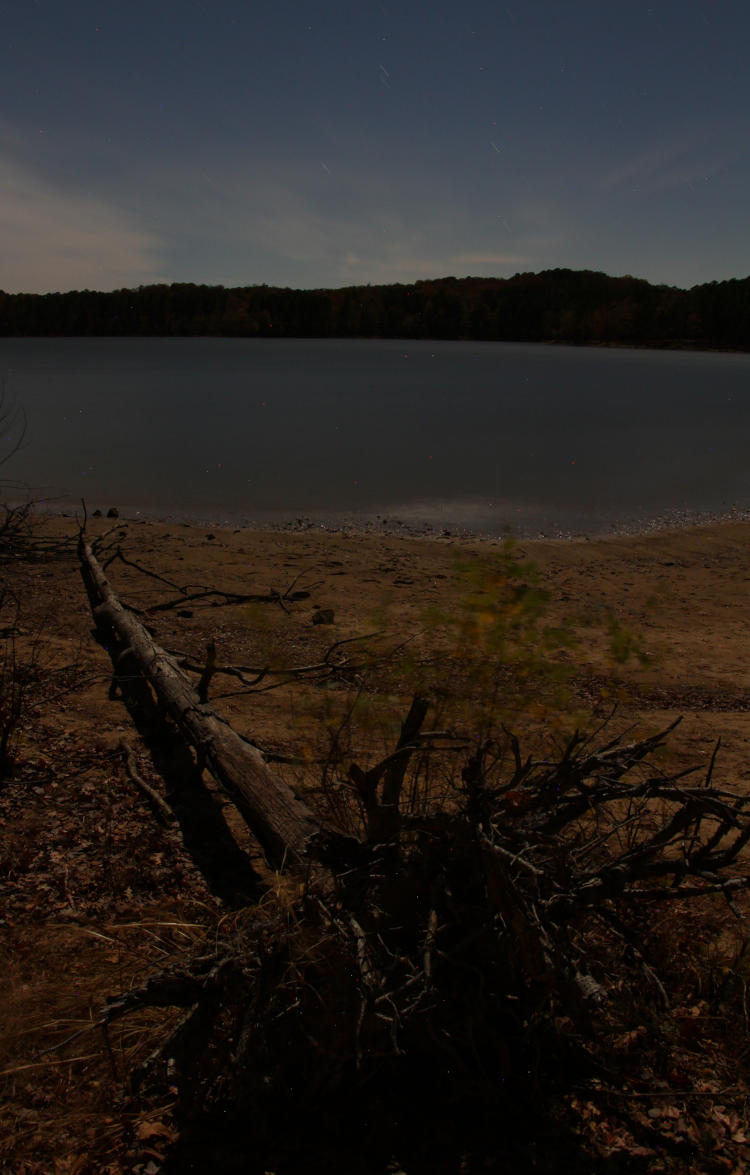
This is around 2:30 EST; the umbral eclipse had started about 15 minutes earlier, and the maximum would not be reached for ninety minutes or so. Yes, I could have been more scenic, had I gone exploring, but no, that wasn’t the purpose, and I wanted to remain within earshot of the car given that it was, you know, early in the morning at a presently-abandoned boat ramp. You can see the evidence of the moon reflecting from the little wavelets at the edge of the water, and I got to see an opossum wander through right underneath that dead tree. Immediately above those roots, you’ll see indistinct green blotches that are the leaves of a small sapling, stirring in the light wind, and if you look closely at the sky, you can see the streaks of the stars indicating that this was not a short exposure: 180 seconds, by my mental count, but 173 by the camera’s – might have the get the camera checked.
Not long after that, I did another progress image.
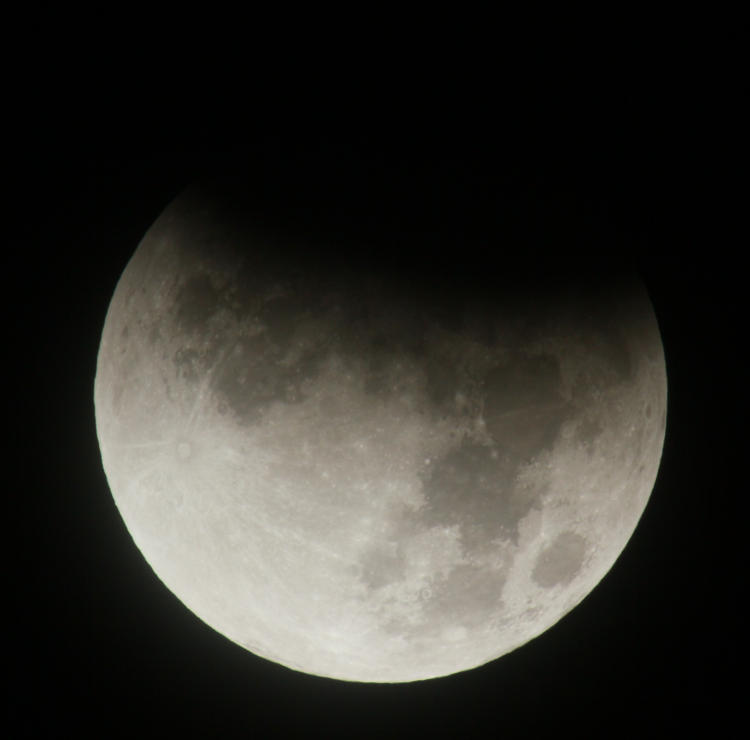
The focusing screen within the camera isn’t distinct enough for really critical manual focus, so I made it a point to refocus constantly to ensure that I would get at least one sharp frame at every step. It paid off too; at later stages, I have sequences of photos where the focus was way off, so I’m glad I made the effort.
Wait – did I just ruin that carefully-crafted suspense? The jury will disregard that last statement.
At slightly better than halfway, I purposefully did some exposures for the shadowed side of the moon, which was tricky, because the non-shadowed side was still very bright. Eventually, I aimed the camera to cut out the majority of the lit side, which reduced the glare noticeably.

This was not visible at all by eye, but we see the hint of red from residual light coming through the Earth’s atmosphere, just like at sunrise and sunset. While the exposures above were at 1/125 sec, f8, ISO 250 (I was shooting through the 2x teleconverter, which reduces light by two stops,) this one was for a full second at f8, seven stops brighter – that’s 128 times more light admitted. And of course, the moonlight was still hitting the lens, just not directly towards the sensor, so the glare was still an issue.
Back to ‘normal’ exposure for this one, a couple of minutes later:
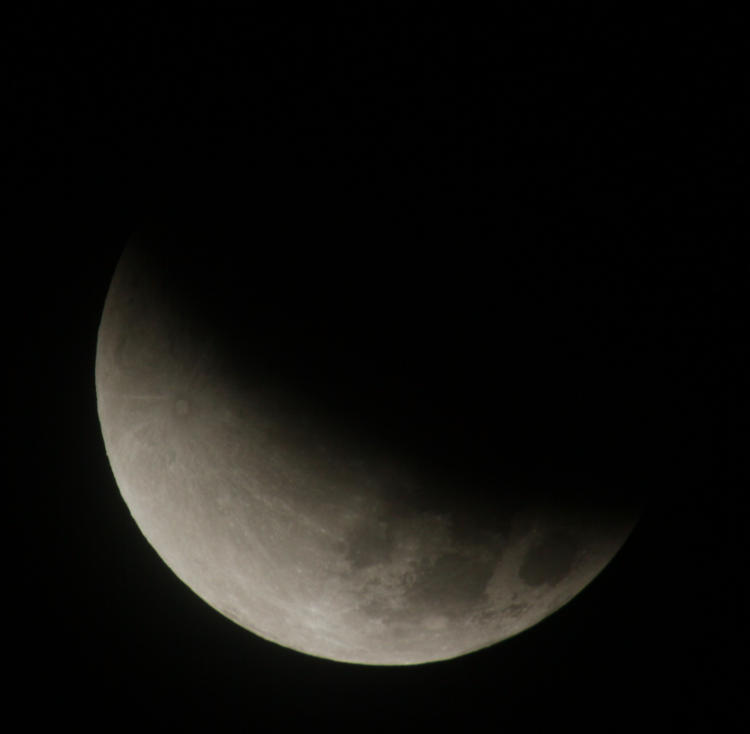
Now, it looked pretty much like a normal moon approaching 1st quarter – if you weren’t aware of the compass direction and where the lit portion should have been (which was rotated around a bit more to the right) or the fact that 1st quarter had already occurred a week ago.
By the way, I was using the ‘Moony 11’ rule for exposure, which states that on clear nights for a full moon, the aperture should be f11, shutter speed 1/ISO, which since I was using ISO 250 would be 1/250 second. This is a variation of the ‘Sunny 16’ rule for manual exposure in bright sunlight (you know, for normal scenics and all that,) and the moon is illuminated by bright sunlight – but we like it a bit brighter white than it really is, which is pretty damn close to middle-grey, that 18% deal that cameras are actually calibrated for, so we add a stop. Except in my case this morning, as noted, the teleconverter itself reduced light by two stops, so to compensate that’s one stop increase in aperture, one in shutter speed, making it 1/125 second at f8. I would not be able to keep this up much longer.
As the moon approached maximum eclipse, still not total (and it wasn’t going to be,) I fired off a last couple of frames for comparison.

Actually, instead of 1/125 second shutter, this is 1/64 – a stop brighter than those above, so now we’re seeing the effect of the penumbra. However, that’s not very interesting, so let’s go to a proper exposure for the conditions.
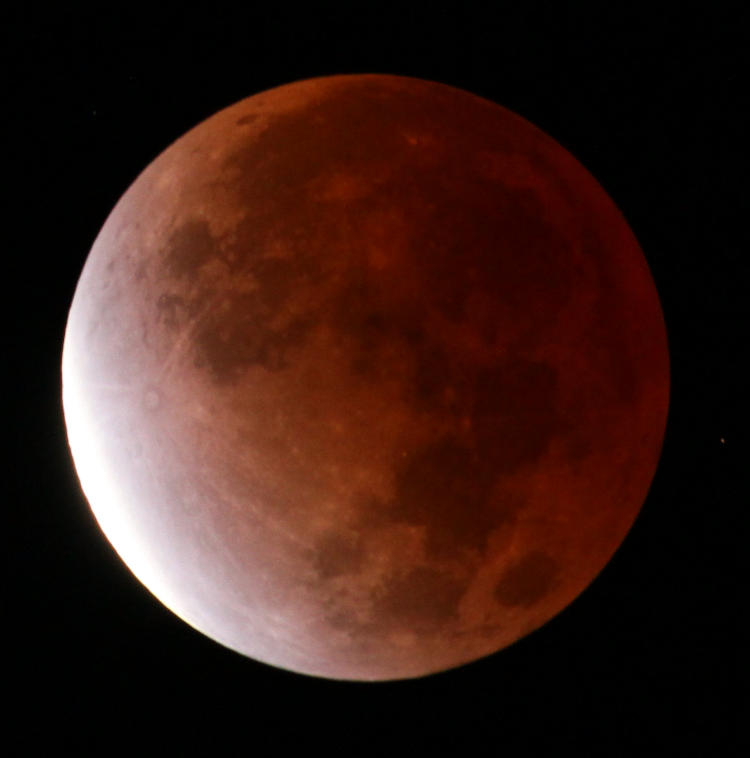
The band of non-eclipsed moonlight is overexposed now, but we can see the remainder of the moon with some decent detail – this is 1/2 second shutter speed, f6.3, ISO boosted to 800. This remained clearly visible in the sky, but very subtle, and overall it had become a dark night with many more stars visible. I did a number of exposures, bracketing wildly to see what worked best, as well as focus-bracketing because all I could focus on decently was that little sliver of still-lit moon, without any lunar details, so that means just the outside edge. I have more than a few that were well out of focus.
But, stars? Yes, that’s one over to the right, and if you look very closely (and your monitor is adjusted decently,) there’s one to upper left too. Let’s have a better look:
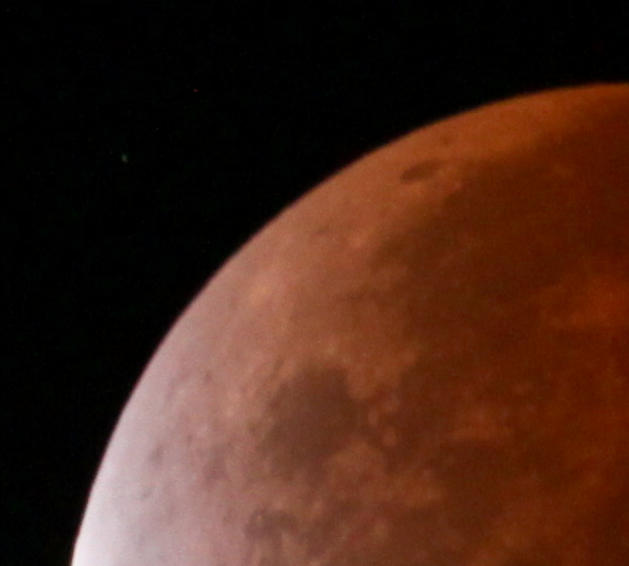
You recall from my previous post (of course) that a particular star was going to be eclipsed itself by the moon, and that’s the dim little bugger right there – HIP 16896, to be exact, with an even dimmer neighbor, and I tweaked this exposure a little to bring them out better. It was so dim that I never located it in the viewfinder, and ruled out doing any long-exposure still shots, much less video (which, in trying to maintain a frame rate, would go for much shorter shutter speeds than this and not even allow the earthglow to be seen – I know, I tried.) This was about ten minutes before it was due to occur, to give you an idea of actual lunar motion, as opposed to earth rotation. And this is as sharp as it was likely to get as well, since we were now in the realm of getting some of that earth rotation within the span of the shutter speed. Again, someday, I will be working with a tracking motor which will allow longer exposures without worrying about motion, though in this case it would have been difficult, since Polaris (which is what such a tracker needs to be oriented upon) was out of my sight within the trees behind me.
Notably, I saw several Leonids meteors this morning – one so distinct and long that I could follow its progress across the sky. None of them gave the faintest appearance of having ‘originated’ from Leo, and that’s been my experience overall, but at least I saw a handful. Given that, as the moon was dark now, I did a few long exposures in the hope of capturing one. Alas, none showed in the direction that I faced the camera (or indeed, anywhere in my sight during the exposures.) But we’ll have a look anyway.
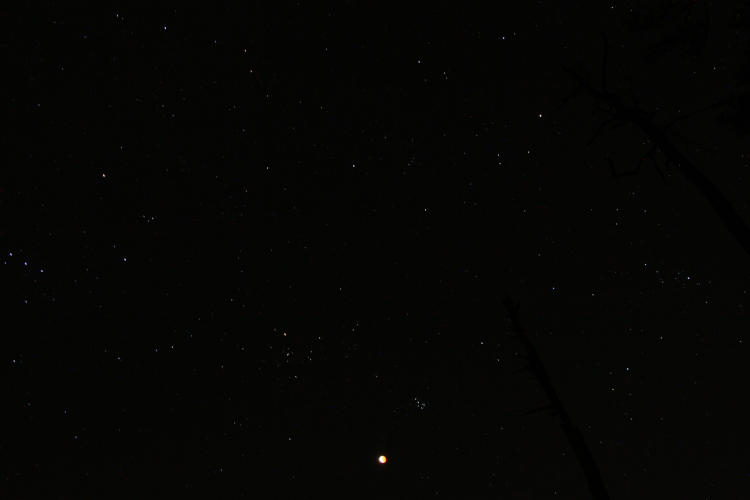
That’s the moon bottom center, now overexposed even as dim as it was, with Pleiades near it to its upper right, Taurus just left of center, and Orion peeking in at the left side – you can see the three belt stars. Again, if your monitor is adjusted decently you may be able to just make out the silhouette of a dead tree trunk right of center. But no meteors – the vivid one had cut through this framing, but better than twenty minutes previously.
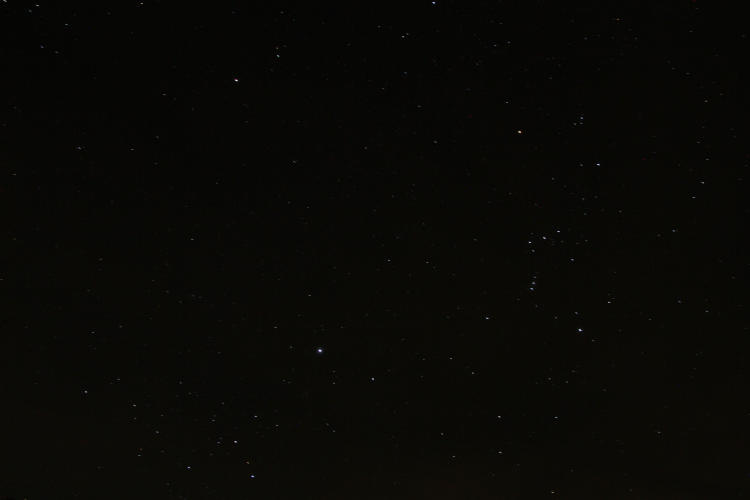
Orion again, and that bright star near center is Sirius; this was both the best view I had in my shooting location, and the darkest sky region, because of both humidity and a lack of city lights within a certain distance. The first meteor I’d seen this morning cut right across Orion’s feet, but that was two hours previously.

This was the last shot of the night, and I knew it wasn’t going to be great because I could just make out those clouds in the city glow, but it’s aimed more or less towards the radiant for the Leonids – I think it’s just above this frame, actually, but certainly a lot closer than the moon or Orion was. The tree limbs were blowing in the breeze – this is not a focus issue. And if you’re looking, you can see that the arcs that the stars make reverse; north is off to the left, while the plane of the ecliptic cuts across closer to the right side of the photo on a diagonal, so the stars ‘below’ that are arcing around the southern end of the earth axis, well out of sight below the horizon here in North Carolina. But no meteors. I saw enough to confirm that the storm was active this year, but by this point I wasn’t inclined to pursue them further – I’d been out for over three hours in supremely chilly conditions, and was sore from sitting cross-legged on the ground under the tripod, so that was enough. I got what I was initially after, so I’m good.



















































